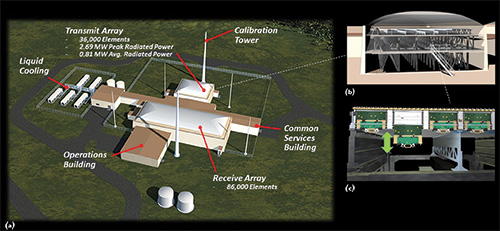 |
| Space Fence radar site (a) cutaway of the transmit array (b) and cross-section of the “radar-on-a-board” transmit LRUs (c). |
While Digital Beam Form (DBF) systems such as Space Fence represent a significant capability upgrade, the challenges from the increased IC design complexity in the areas of size, weight and power (SWAP), bandwidth and latency performance must be overcome. To address this, programs such as DARPA’s Diverse Accessible Heterogeneous Integration (DAHI) program are focused on developing chip-scale integration of GaN with high density Si CMOS, as well as other technologies such as InP and MEMS. These resulting capabilities will enable the wider proliferation of the high performance mixed-signal integration solutions required to develop the capabilities to further advance state-of-the-art sensor systems.
The next generation of GaN development is focused around increasing capability by pushing into higher operating frequencies, improving thermal performance and enabling chip-scale integration of GaN with other IC technologies. Developments of 150 nm and 90 nm process nodes will extend ft to 60 and 100 GHz, respectively.
While GaN is capable of generating extremely high RF power densities, thermal management remains a significant challenge, especially at higher frequencies where thermal density is most extreme. On the DARPA IceCool program, Lockheed Martin has made tremendous gains in unlocking the ultimate potential of millimeter wave GaN by developing a micro-fluidically cooled HPA with a 3×reduction in thermal resistance compared to conventional thermal management solutions. This IceCool solution enables an 8.3 dB increase in output power for the same device, while simultaneously reducing operating temperature by increasing power-added efficiency between 2.5× and 3.5×.9 Overall, these advancements will further extend the true potential of GaN and its ability to realize tremendous capability upgrades for a wide variety of systems.
No comments:
Post a Comment